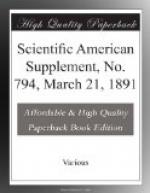It is our aim this afternoon to look into this question in so far as the diameter of the wheel affects it, and in doing it we must consider what liability there is to breakage or derangement of the parts of the wheel, hot journals, bent axles, the effect of the weight of the wheel itself, and the effect upon the track and riding of the car, handling at wrecks and in the shop, the first cost of repairs, the mileage, methods of manufacture, the service for which the wheel is intended and the material of which it is made.
Confining ourselves to freight and passenger service, and to cast iron and steel wheels in the general acceptation of the term as being the most interesting, we know that cast iron is not as strong as wrought iron or steel, that the tendency of a rotating wheel to burst is directly proportional to its diameter, and that the difficulty of making a suitable and perfect casting increases with the diameter. Cast iron, therefore, would receive no attention if it were not for its far greater cheapness as compared to wrought iron or steel. This fact makes its use either wholly or in part very desirable for freight service, and even causes some roads in this country, notably the one with which I am connected, to find it profitable to develop and perfect the cast iron wheel for use in all but special cases.
Steel, on the other hand, notwithstanding its great cost, is coming more and more into favor, and has the great recommendations of strength and safety. It is also of such a nature that wheels tired with it run much further before being unfit for further service than those made of cast iron, and consequently renewals are less frequent. The inference would seem to be that a combination of steel and cast iron would effect the desirable safeness with the greatest cheapness; but up to the present this state of affairs has not yet been realized to the proper extent, because of the labor and cost necessary to accomplish this combination and the weakness involved in the manner of joining the two kinds of material together.
Taking up the consideration of the diameter of the wheel now, and allowing that on the score of economy cast iron must be used for wheels in freight service, we are led to reflect that here heavy loads are carried, and there is a growing tendency to increase them by letting the floor of the car down to a level with the draft timbers. All this makes it desirable to have the wheels strong and small to avoid bent axles and broken flanges, to enable us to build a strong truck, to reduce the dead weight of cars to a minimum, and have wrecks quickly cleared away. The time has not yet come when we have to consider seriously hot journals arising from high speed on freight trains, and a reasonable degree only of easy riding is required. The effect on the track is, however, a matter of moment. Judging from the above, I should say that no wheel larger than one 33 in. in diameter should be used under freight cars. Since experience in passenger service shows that larger cast iron wheels do not make greater mileage and cost more per 1,000 miles run, and that cast iron wheels smaller than 33 in., while sometimes costing less per 1,000 miles run, are more troublesome in the end, it is apparent that 33 in. is the best diameter for the wheels we have to use in freight service.




